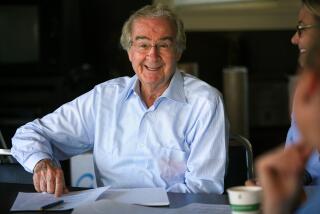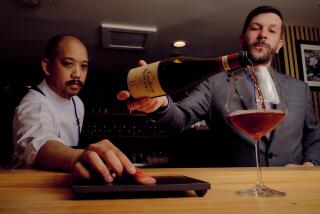State Near Bottom of Barrel of Wine Grape Scandal : Fraud: Wineries that unwittingly bought overpriced grapes simply used them to make overpriced wine. New safeguards are now in place.
SACRAMENTO — Nobody was killed, unlike in the great Italian wine scandal of 1986, when vintners used methanol to boost sugar levels and sent two dozen wine drinkers to early graves. Now that was serious.
But by California’s priggish wine standards, the scandal that is drawing to a close here in Federal Court--a series of sneaky crimes whereby cheap, characterless grapes were passed off as pricey zinfandel, chardonnay or cabernet--was the biggest in modern times.
Consumers paid some $55 million for wine that was not as advertised, five men went to jail and the president of the nation’s fifth-largest winery has just pleaded guilty to a charge of conspiracy in the largest and most complex of five criminal cases arising from the schemes.
The cases showed a raw side of what is described as a generally friendly, handshake-based industry--the bargain-basement part of the wine world where a few bottom fishers care less about what is in the bottle than how much shelf space they get in the supermarket.
Very few people were directly damaged by the fraud, and even the murder of a witness in one of the cases turned out to be unrelated. And while a handful of wine outlaws collected millions of dollars they weren’t entitled to, the wineries that unwittingly bought the overpriced grapes simply used them to make overpriced wine.
That left the consumer holding the bottles--in most cases a $5 bottle of bogus white zinfandel, a sweet pink wine much derided by connoisseurs. But in wine circles they say that “white zin” would taste the same whether it was made with zinfandel grapes or, say, barbera, a kind of grape blended with others to make generic jug wines.
Still, the very integrity of California’s $20-billion wine industry was at stake. “Some people snicker at these cases,” says one federal investigator, accustomed to arresting gun-runners, drug traffickers and other hard-core sorts. “But you’ve got to have standards in any industry.”
The criminal investigation that began in 1988 is now complete, and authorities, growers and vintners say that it triggered new industry-funded safeguards that have all but halted the practice of misrepresenting grapes and wine. But the matter has not quite been put to rest.
Still to be decided is the penalty to be handed down against the man whom the government portrays as the chief figure in the biggest and most sophisticated of four criminal ventures unmasked in the scandal: Fred T. Franzia, co-founder and president of Bronco Wine Co., the nation’s fifth largest winery.
Franzia’s indictment by a federal grand jury in Sacramento in December marked the end--and arguably the high point--of the five-year investigation of fraud in California’s wine industry.
(Fred Franzia and Bronco are unaffiliated with Franzia Brothers Winery in Ripon, Calif., which sells Franzia-label wines. Bronco, its name is derived from “brothers and cousin,” is owned by Fred Franzia, his brother, Joseph, and their cousin, John Jr.).
Franzia, 50, a nephew of industry statesman Ernest Gallo, is a director and former chairman of the influential Wine Institute--trade association representing 80% of the wine produced in California--and a highly successful businessman who built Bronco Wine from scratch.
Franzia declined to be interviewed. He has a reputation as a bull in the wine shoppe--widely described by acquaintances as smart but boastful, arrogant and brash, ready to intimidate employees, squeeze growers and fight battles in court. By all accounts he runs the company single-handedly.
“Employees and others with whom Franzia deals are afraid of him,” says Assistant U.S. Attorney R. Steven Lapham, who prosecuted all the wine cases. “I’m not sure what it is, if it’s his manner or the economic power he holds.”
Bronco’s license was suspended briefly by state agriculture officials in 1985, a rare action, after complaints by an unprecedented number of growers.
The company was found to have repeatedly used improper tactics to lower the prices it paid growers for their grapes, typically by refusing to take deliveries until the grape quality had deteriorated. In the words of one hearing officer, Bronco’s actions were “reprehensible.”
Now Franzia has struck a deal with federal prosecutors to avoid a prison term in favor of a $3-million fine--much of which, the government admits, is payable from ill-gotten gains. If this plea bargain is accepted by the judge, Franzia will be the only one of six defendants identified as major conspirators in the series of wine frauds to avoid incarceration.
Franzia pleaded guilty Jan. 19 in Sacramento federal court under an agreement that reduces his role at Bronco to chief financial officer for five years, requires 500 hours of community service and imposes fines of $500,000 and $2.5 million on him and his company.
“He’s bought his way out,” says Jack L. Hart, a longtime wine industry lender as a Fresno-based Bank of America vice president. “That’s what is so upsetting,”
By contrast, a former client of Hart’s, 72-year-old Madera winemaker Angelo Papagni, is serving an 18-month term in federal prison for a lesser scheme than Franzia’s. Hart and others are trying to get Papagni released early.
“It’s not equitable,” concedes prosecutor Lapham.
Lapham said he recommended the plea agreement because he believed that Bronco, a major employer in the small town of Ceres near Modesto, might not survive without Franzia--a judgment strongly denied by Bronco itself. Moreover, he said, the plea bargain avoids a difficult and expensive trial.
U.S. District Judge William B. Shubb in Sacramento will decide whether to accept the terms of the plea bargain. Sentencing is set for March.
Whatever the merits of Franzia’s proposed penalty, it is touted as the biggest fine ever levied in the Eastern District of California, which extends from Bakersfield to Oregon and Nevada to the Bay Area. And his case culminates the state’s worst wine scandal--not that there is a lengthy list to compare with.
The last such known deception occurred in 1974, when Almaden Vineyards mislabeled 28,000 gallons of wine in the little screw-top bottles served by airlines. The company paid a $250,000 fine, at the time the heaviest ever imposed by the U.S. Bureau of Alcohol, Tobacco and Firearms.
Even then, the Almaden case was dwarfed by a French scandal in which 2 million cases of cheap red wine were passed off as the most expensive Bordeaux.
The more recent California disgrace was set in motion by severe 1987-88 shortages of certain grapes--especially zinfandel, cabernet and chardonnay--when the industry was caught unprepared by the soaring popularity of a new category of medium-priced varietal wines.
Varietals are those at least 75% composed of the grape cited on the label, and include such wines as cabernet sauvignon, zinfandel, sauvignon blanc and chardonnay. Generic wines--typified by California burgundy and chablis or those simply labeled as table wines, often sold in big jugs--are blends of many types and are said to have no “character.”
In heaviest demand--and the focus of most of the fraud--was white zin, a newly conceived product whose flavor resembles sweet rose wines but has the hallowed “zinfandel” name on the label. It and similar pink “blush” wines have been called “Yuppie Kool-aid.”
Though absent altogether from the wine snob’s list, the combination of the red zinfandel grape with cheaper, generic white fruits came to mean big bucks for many well-known California wineries. It brings in cash quickly because it needs little or no aging.
But the shortages vaulted zinfandel prices to $800 to $1,200 a ton, while other types of red grapes used in generic jug wines--valdepena, Grenache, Ruby Cabernet, carnelian and others--were in plentiful supply and could be had for $100 to $200.
With falsification of documents and a few other wrinkles, a grower or broker could collect $15,000 to $25,000 for a gondola full of supposed zinfandel grapes that were actually valdepenas worth $5,000.
The scams were facilitated by lax controls at some wineries--apparently not a problem at the better wineries in Napa, Sonoma and other regions--and the difficulty of conclusively identifying some grape types.
“It became a real temptation,” says Mark Urban, a deputy state attorney general who filed 17 civil complaints--all settled out of court with the payment of fines--arising from the joint state-federal investigation.
“A lot of growers got a little bit greedy, a few people got a lot greedy, truckers started looking the other way, and it just got completely out of hand.”
Rumors swept the industry during the 1987 harvest, and numerous growers and vintners tipped off state and federal authorities. As the next harvest began, dozens of vineyards were put under surveillance by investigators from the California Department of Food and Agriculture and the ATF.
Using public records to identify the types of grapes grown in the vineyards, agents watched as grapes were loaded into trucks, then followed the trucks to wineries. They then checked winery records and determined that the delivered grapes had been misrepresented.
At Bronco, more than 15% of the “zinfandel” and about half the “cabernet” crushed by the winery in 1987 was actually something else, said another federal investigator who asked not to be identified.
For Bronco--which mainly sells non-varietal wine in bulk to companies that sell it under their own labels, some as wine coolers--this represented only about 3% of the winery’s overall tonnage that year.
But because of the inflated prices, the misrepresented grapes accounted for a considerably higher proportion of Bronco’s revenues, investigators said. And because of the shortages, the fraud enabled Bronco to fill orders that law-abiding winemakers couldn’t.
According to the indictment, Franzia would sometimes order that zinfandel leaves, distinctive in their shape, be sprinkled on truckloads of cheaper grapes as part of the subterfuge. He called this the “blessing of the loads,” court papers show.
He would order that field identification tags be altered or destroyed, the indictment said. And to launder revenues that wouldn’t withstand the glare of investigation, he allegedly enlisted an unwitting, well-known wine broker--later a grand jury witness--to whom he owed money.
On three occasions, he wrote checks to the broker totaling $2.9 million, supposedly as payment for expensive grapes, according to the indictment. The broker then would write slightly smaller checks to one of a series of partnerships controlled by Franzia. The broker would keep the difference as payment of bills for previous, legitimate services.
Bronco treasurer Daniel J. Leonard also declined to discuss the case, noting that this is a “ticklish period” with sentencing yet to come. He produced a letter from the winery to its customers and growers in which Franzia said: “I accept responsibility for what happened six years ago.”
The letter also said Bronco cooperated fully and had “voluntarily” turned over 100,000 pages of records. But prosecutor Lapham said, “If you call cooperation responding to grand jury subpoenas and court orders, Bronco cooperated. If you’re talking about voluntarily coming forward, they didn’t cooperate, in my view.”
Conspicuous by its absence from any brush with the scandal was E & J Gallo Winery in Modesto, the biggest vintner of all, where security and quality controls are legendary and winemakers literally stand guard at the gate as trucks roll in during the harvest.
But the irregularities by Franzia, a nephew of co-founder Ernest Gallo’s late wife, didn’t appear to affect his standing in the family. Asked to comment, Ernest, 85, said through a spokesman: “I have a high regard for Fred Franzia.”
And as chief financial officer at Bronco, he remains “a director in good standing” at the Wine Institute, says President John DeLuca. “There hasn’t even been one person who’s raised a question about it.”
Times Staff Writer Dan Berger contributed to this story.


